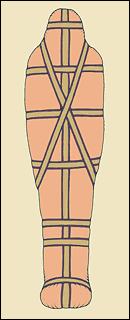The
earliest ancient Egyptians buried their dead in small pits in the desert. The
heat and dryness of the sand dehydrated the bodies quickly, creating lifelike and natural
'mummies'.
Over
many centuries, the ancient Egyptians developed a method of preserving bodies
so they would remain lifelike. The process included embalming the bodies and wrapping them in strips
of linen. Today we call this process mummification.
How
bodies were mummified?
An important man
has died and his body needs to be prepared for burial.
The process of
mummification has two stages. First, the embalming of the body. Then, the
wrapping and burial of the body.
Embalming
the body
First,
his body is taken to the tent known as 'ibu' or the 'place of purification'.
There the embalmers wash his body with good-smelling palm
wine and rinse it with water from the Nile .
One of the
embalmer's men makes a cut in the left side of the body and removes many of the
internal organs. It is important to remove these because they are the first
part of the body to decompose.
The
liver, lungs, stomach and intestines are washed and packed in natron which
will dry them out. The heart is not taken out of the body because it is the
centre of intelligence and feeling and the man will need it in
the afterlife.
A long hook is used
to smash the brain and pull it out through the nose.
The
body is now covered and stuffed with natron which will dry it out. All of the
fluids, and rags from the embalming process will be saved and buried along with
the body.
After
forty days the body is washed again with water from the Nile .
Then it is covered with oils to help the skin stay elastic.
The dehydrated internal organs are wrapped in linen and returned to the body. The body is
stuffed with dry materials such as sawdust, leaves and linen so that it looks
lifelike.
Finally
the body is covered again with good-smelling oils. It is now ready to be
wrapped in linen.
In the
past, when the internal organs were
removed from a body they were placed in hollow canopic jars.
Over many years the
embalming practices changed and embalmers began returning internal organs to
bodies after the organs had been dried in natron. However, solid wood or stone
canopic jars were still buried with the mummy to symbolically protect the
internal organs.
Wrapping
the mummy
First
the head and neck are wrapped with strips of fine linen. Then the fingers and
the toes are individually wrapped.
The
arms and legs are wrapped separately. Between the layers of wrapping, the
embalmers place amulets to protect the body in its journey
through the underworld.
A
priest reads spells out loud while the mummy is being wrapped. These spells
will help ward off evil spirits and help the deceased make the journey to the afterlife.
The
arms and legs are tied together. A papyrus scroll with spells from the Book of
the Dead is placed between the wrapped hands.
More
linen strips are wrapped around the body. At every layer, the bandages are
painted with liquid resin that helps to glue the bandages
together.
A
cloth is wrapped around the body and a picture of the god Osiris is painted on
its surface.
Finally, a
large cloth is wrapped around the entire mummy. It is attached with strips of
linen that run from the top to the bottom of the mummy, and around its middle.
A board of painted
wood is placed on top of the mummy before the mummy is lowered into its coffin.
The first coffin is then put inside a second coffin.
The
funeral is held for the deceased and his family mourns his death.
A ritual called the 'Opening of the Mouth' is
performed, allowing the deceased to eat and drink again.
Finally, the body
and its coffins are placed inside a large stone sarcophagus in the tomb. Furniture, clothing,
valuable objects, food and drink are arranged in the tomb for the deceased.
Now his body is
ready for its journey through the underworld. There his heart will be judged by
his good deeds on earth. If his heart is found to be pure he will be sent to
live for all eternity in the beautiful 'Field of Reeds'.






















No comments:
Post a Comment